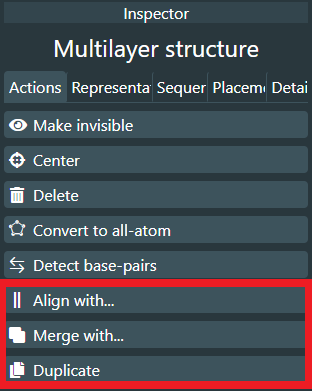Superassemblies
One of the goals of Catana is to facilitate the creation of superassemblies.
This goal is supported by multitude of features offered by Catana (described in other sections of this manual), ranging from modifications of individual structures, through various visualization possibilities up to export to various file formats.
In this section, the focus is mainly onto the placement of individual structures in space in order to end up with the desired spatial assembly.
Translation and rotation of structures
There are various ways how to translate or rotate structures in Catana. In its core, the users can directly modify the raw values using the Placement section in the Inspector view or use corresponding tools available in the Gizmos panel, as shown below.

As for the tools, after selection of one of them from the Gizmos panel, you can continue in two ways:
- Click on any part of a structure to show the translation or rotation gizmo (visible in image below), which will consider the selected part as a center of rotation. The user can then drag the gizmo handles to move or rotate the structure around the selected axis.
- Other approach is to on click on a structure and immediately drag with a mouse around, which will result in a translation or rotation being performed correspondingly to the mouse movement.
Furthemore, Catana enables to lock certain components (using the lock icon in Workspace or via the Placement tab). This will disable component translations and rotations, making it fixed in space. This enables to avoid user errors caused by the inadvertent movement of a structure during the creation of superassembly.

Additional features
Finally, to facilitate the creation of superassemblies or comparison of individual involved structures, Catana provides additional features, such as possibility to duplicate structures. merge them or superpose them.
